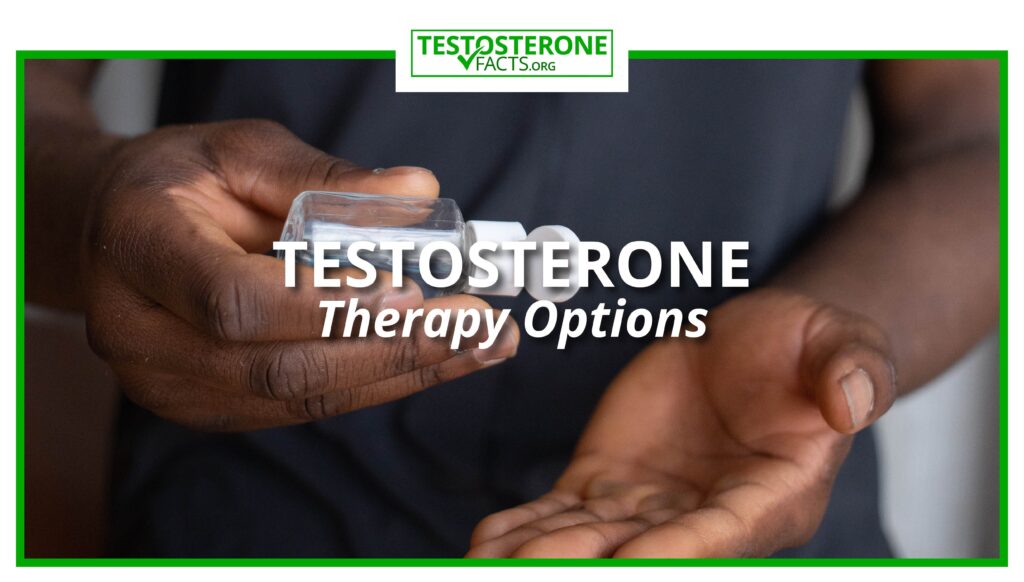
Testosterone Therapy Options
- TFacts Staff

Table of Contents
ToggleIntroduction
Testosterone, a crucial hormone for men’s health, can sometimes dip to low levels, leading to a range of symptoms such as fatigue, reduced muscle mass, and decreased libido. Fortunately, there are several testosterone therapy options available to address these issues. This article delves into the key takeaways from these options, considerations, risks, and the importance of consulting a healthcare provider for personalized guidance.
Key Takeaways
- Testosterone Therapy Options: Testosterone therapy comes in various forms, including injections, topical gels, and pellet implants
- Testosterone Injections: Injections deliver synthetic testosterone into muscles, gradually releasing it into the bloodstream
- Topical Gels: They are applied to the skin and absorbed into the bloodstream, providing a steady hormone release
- Pellet Implants: Pellets implanted under the skin release testosterone slowly over months, maintaining consistent hormone levels
- Considerations and Risks: Side effects of testosterone therapy include acne, prostate issues, and fluid retention
Testosterone Therapy Options
Testosterone therapy options include testosterone injections, topical gels, and pellet implants.
Testosterone Injections
Testosterone injections are a common form of testosterone replacement therapy for men with low testosterone levels. These injections deliver synthetic testosterone directly into the muscle, allowing it to be slowly released into the bloodstream over time.
This method can help improve symptoms such as fatigue, decreased libido, and reduced muscle mass associated with low testosterone levels.
However, it’s important to note that testosterone injections should only be administered under the supervision of a healthcare provider, as they can have potential side effects such as acne, enlarged prostate, or decreased sperm count. Regular monitoring of hormone levels is also necessary to ensure optimal treatment outcomes.
Topical Gels
One option for boosting testosterone levels is the use of topical gels. These gels contain synthetic testosterone that can be easily applied to the skin and absorbed into the bloodstream.
They are a convenient and non-invasive way to increase testosterone levels without requiring injections or implants. Topical gels provide a steady release of the hormone throughout the day, helping to maintain more consistent levels in the body.
Note that while topical gels can be effective, they do have potential side effects, such as skin irritation at the application site and transfer of testosterone to others through skin contact, so caution should be exercised when using them.
Pellet Implants
Pellet implants are a form of testosterone therapy that involves placing small pellets under the skin, typically in the buttocks or hip area. These pellets slowly release testosterone into the body over several months, providing a steady and consistent level of hormone replacement.
This treatment option is convenient for those who want to avoid daily applications or injections and can help improve symptoms associated with low testosterone levels, such as decreased sex drive, fatigue, and reduced muscle mass.
However, consult with a healthcare provider to determine if pellet implants suit your specific situation and to discuss potential risks or side effects.
Considerations and Risks of Testosterone Therapy
Considerations and risks associated with testosterone therapy include the potential for side effects, the need for ongoing monitoring of hormone levels, and the long-term effects of treatment.
Potential Side Effects
Testosterone replacement therapy can have some potential side effects that men should be aware of. These can include acne, enlarged prostate, shrinking testicles, decreased sperm count, high red blood cell count, fluid retention, and swollen feet or ankles.
Understand that not everyone will experience these side effects, and they may vary in severity. Before starting any testosterone therapy, it’s essential to discuss the potential risks and benefits with a healthcare provider to determine if it is the right treatment option for you.
Monitoring Hormone Levels
Regular monitoring of hormone levels is crucial for men experiencing low testosterone. By regularly checking hormone levels, healthcare providers can determine the effectiveness of any treatment plan and make necessary adjustments if needed.
Hormone level testing involves a simple blood test that measures testosterone levels in the body. This test can provide valuable information about overall hormonal health and guide treatment decisions.
The hormone levels fluctuate throughout the day, so testing should be done at specific times to get accurate results. Regular monitoring ensures that men receive appropriate care tailored to their individual needs and helps maintain optimal testosterone levels for better physical and mental well-being.
Long-Term Effects
Over the long term, low testosterone levels can significantly affect a man’s health and well-being. One important aspect to consider is the impact on bone density. Testosterone plays a crucial role in maintaining strong and healthy bones. So, when levels are consistently low, it can lead to reduced bone mineral density and an increased risk of fractures and osteoporosis.
Furthermore, low testosterone has also been linked to cognitive decline and an increased risk of developing conditions such as Alzheimer’s disease.
Men over 30 interested in health should proactively maintain optimal testosterone levels through exercise, sleep, diet, stress management, seeking medical advice, and considering treatments under professional guidance.
Consulting with a Healthcare Provider
It’s important to consult with a healthcare provider when considering treatment for low testosterone levels. They can perform hormone level testing and help create a personalized treatment plan that suits your needs. Don’t hesitate to seek medical advice to improve your overall health and well-being.
Importance of Medical Advice
It is crucial for men above 30 who are interested in their health and fitness to seek medical advice when it comes to low testosterone levels. Low testosterone can have various symptoms and potential health risks, greatly impacting overall well-being.
By consulting with a healthcare provider, individuals can undergo hormone level testing and receive personalized guidance on the most suitable treatment plan. This ensures that any underlying conditions or contributing factors are properly addressed, leading to better outcomes and improved quality of life.
Hormone Level Testing
Testing hormone levels is a crucial step in diagnosing low testosterone. By measuring the amount of testosterone in your blood, healthcare providers can determine if you have low T and the appropriate treatment plan for you.
The test involves a simple blood draw, usually done in the morning when testosterone levels are highest. It’s important to note that symptoms alone cannot confirm low testosterone, so getting tested is essential for an accurate diagnosis.
With this information, you and your healthcare provider can work together to address any imbalances and find the best course of action to boost your overall health and well-being. Remember, seeking medical advice is key in determining the most effective approach for managing low testosterone levels.
Finding the Right Treatment Plan
To find the right treatment plan for low testosterone levels, it is important to consult with a healthcare provider who specializes in hormone therapy. They will evaluate your symptoms, conduct hormone level testing, and discuss your medical history to determine the most appropriate course of action.
Treatment options can range from lifestyle modifications to testosterone replacement therapy. Working closely with your healthcare provider is crucial to find the best approach tailored specifically to you.
Remember, addressing low testosterone levels can improve various aspects of health and well-being, so don’t hesitate to seek professional guidance.
Conclusion
Maintaining optimal testosterone levels is integral to men’s overall health and well-being. Testosterone therapy options, including injections, topical gels, and pellet implants, offer ways to alleviate symptoms and enhance quality of life. However, carefully considering potential risks and benefits and consulting a healthcare provider is essential to tailor an effective treatment plan. Regular monitoring and personalized guidance ensure better outcomes and a healthier life.
FAQs
1. What are the common testosterone therapy options?
Common testosterone therapy options include injections, topical gels, and pellet implants.
2. What are the potential side effects of testosterone injections?
Potential side effects of testosterone injections include acne, enlarged prostate, and decreased sperm count.
3. How do topical gels work for testosterone therapy?
Topical gels are applied to the skin and absorbed into the bloodstream, providing a steady release of testosterone throughout the day.
4. What is the role of pellet implants in testosterone therapy?
Pellet implants release testosterone slowly over several months, maintaining consistent hormone levels.
5. What are the risks associated with testosterone therapy?
Risks include potential side effects like acne and fluid retention. Long-term risks involve bone density issues and cognitive decline.
6. Why is hormone level monitoring important during testosterone therapy?
Regular monitoring ensures treatment effectiveness and allows adjustments to be made if needed for optimal outcomes.
7. How does low testosterone affect bone health?
Low testosterone can lead to reduced bone density and an increased risk of fractures and osteoporosis.
8. Why is it important to consult a healthcare provider for testosterone therapy?
Consulting a healthcare provider ensures personalized treatment plans, proper monitoring, and guidance tailored to individual needs.
9. Can symptoms alone confirm low testosterone levels?
No, symptoms alone cannot confirm low testosterone levels. Hormone-level testing is essential for accurate diagnosis.
10. How can I find the right treatment plan for low testosterone levels?
Consult a healthcare provider specializing in hormone therapy to evaluate symptoms, conduct testing, and determine the most suitable approach tailored to you.
Share:
Sponsored Brand




